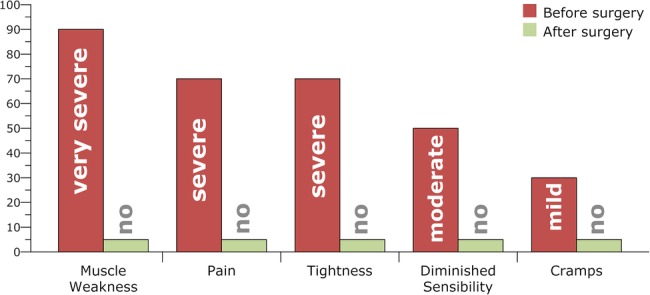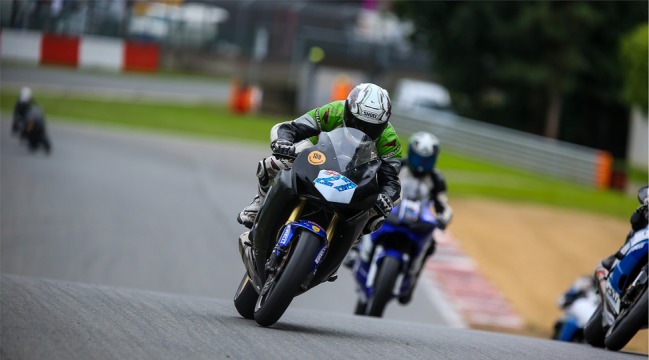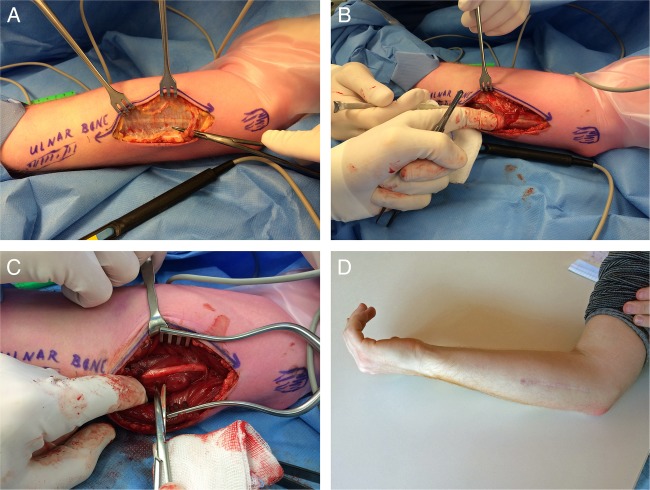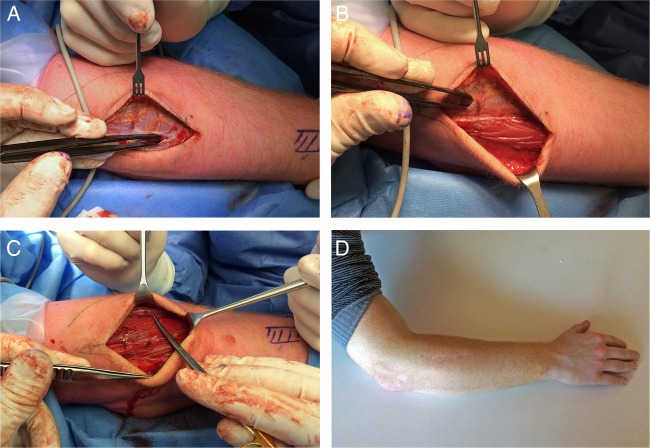Abstract
We discuss a case of a 26-year-old man, a motorcycle racer, who presented with progressive pain, weakness and swelling of his right forearm and loss of power in his index finger, experienced during motor racing. Chronic exertional compartment syndrome (CECS) of both flexor and extensor compartments of his forearm was diagnosed by dynamic intracompartmental muscle pressure measurements. After fasciotomies, all symptoms were resolved and the patient was able to improve on his preinjury racing skills, without any limitations. A literature review and a surgical ‘how-to’ for correct release of the extensor and deep flexor compartments of the forearm are provided.
Background
Chronic exertional compartment syndrome (CECS) is a disabling condition that is most commonly observed in the legs. Repetitive intense muscle activity during sports is thought to cause increased intracompartmental blood volume, hypertrophy and oedema, leading to inappropriately elevated muscle compartment pressures because of a too tightly enveloping fascia. As venous return is hampered, lactate accumulation results in pain and muscle weakness. As most patients of these conditions are fanatic sports participants, conservative regimens including rest are often rejected. Fasciotomy of the affected compartments should be considered.
CECS is almost always diagnosed in the lower legs. The forearm is rarely affected. Only a few case reports and small case series have been reported. If present, a bilateral lower arm flexor muscles CECS is diagnosed in 95% of cases.1–3 A combined unilateral lower arm extensor and flexor CECS is exceedingly rare with an unknown incidence. Moreover, pictures of the surgical release of the extensor compartment have not been reported before.
Case presentation
A 26-year-old man, a track motorcyclist, presented to our sports medicine department, with a 1-year history of progressive weakness of his right index finger, accompanied by pain, weakness and swelling of the right forearm. He reported that symptoms were more prominent towards the end of races. More recently, he had noticed that the pain had already started within 5 min after the start of a race. He was not able to finish his last few races due to this severe discomfort. Pain intensity appeared to be related to the number of braking manoeuvres. Frequent and intensive braking, especially required on short tracks with multiple curves, caused swelling, tightness and tense muscle compartments in his right forearm. As a result, he could no longer control the hand brake lever, and he was also unable to flex his index finger. Moreover, he felt progressive numbness of the palmar portions of his right hand. The swelling and tightness usually disappeared within 1 h after racing. However, numbness and weakness of the hand was present until the day after. Other sports such as swimming and weight lifting did not provoke any right lower arm discomfort. Hitherto, medication, rest, ointments and physiotherapy were to no avail.
Investigations
On inspection, both forearms appeared normal. Skin sensation, motor function as well as ulnar and radial arterial pulsations of both arms were normal. Provocation of the flexor and extensor muscles of both forearms using fitness grippers resulted in tense flexor and extensor muscle compartments on the right side only. However, right-sided weakness of the index finger could not be evoked.
Carpal tunnel syndrome was excluded by a nerve conducting study. A questionnaire scoring symptoms frequently associated with CECS suggested the presence of chronic compartment syndrome.3 As a combined lower arm flexor and extensor CECS was assumed, intracompartmental pressures (ICP) of both muscle compartments of the right forearm were obtained as reported earlier.4 Values in the deep flexor compartment were 16 mm Hg during rest, which increased to 40 mm Hg immediately after maximal provocation using fitness grippers, and 36 and 35 mm Hg at 1 and 5 min thereafter, respectively. Pressures in the extensor compartment were also elevated (16, 34, 32 and 28 mm Hg, respectively).
Differential diagnosis
The differential diagnosis of upper extremity exertional pain is extensive and includes syndromes of muscular/tendon origin (tenosynovitis, muscle strain, forearm CECS, contusion, intersection syndrome), bone/periosteum (epicondylitis, stress fracture, little league elbow), nerves (thoracic outlet syndrome, pronator syndrome, entrapment syndromes), vascular (Paget-Schroetter syndrome or effort thrombosis, intermittent vascular claudication, vascular compression syndromes) or of an infectious origin (osteomyelitis). As the results of the patient's history-taking and physical examination were highly suggestive of lower arm CECS, most of these potential alternative conditions were ruled out by physical examination. Nerve conduction studies and electromyography (EMG) excluded nerve entrapment and neuromuscular disease. Duplex ultrasound and CT/MR angiography are suitable for the detection of vascular compression syndromes but were not performed, since the index of suspicion was too low.
Treatment
After informed consent, the patient underwent a fasciotomy of both lower arm compartments in day care. After induction of general anaesthesia and sterile exposure, an 8 cm longitudinal incision just ulnar to the midline on the volar aspect of the lower arm allowed access to the superficial flexor compartment (figure 1). Branches of the medial cutaneous nerve were identified and preserved. The subcutaneous fascia covering the flexor carpi ulnaris, flexor digitorum superficialis and flexor carpi radialis muscles was freed from subcutaneous tissue and opened over a length of 15–20 cm. The plane between the carpi ulnaris and digitorum superficialis muscles was used to gain access to the deep flexor muscles enveloping the ulnar bone. The ulnar nerve overlying this deep fascia covering the flexor digitorum profundus and flexor pollicis longus muscle was identified and preserved (figure 1C). The deep flexor fascia was incised using a knife and scissors. Subsequently, a 6 cm longitudinal incision over the proximal portions of the superficial extensor compartment allowed access to the superficial fascia that was freed from subcutaneous tissue. Two separate fasciae covering the extensor digitorum and extensor carpi ulnaris muscles were opened in both, proximal and distal directions (figure 2). Using superficial muscle retraction, the extensor carpi radialis fascia was identified and opened. Both surgical wounds were closed using standard techniques.
Figure 1.
Superficial and deep fasciotomy for chronic exertional compartment syndrome of the flexor side of the forearm. An 8 cm longitudinal incision on the volar aspect of the proximal forearm allowed exposure to the superficial volar fascia covering the flexor carpi ulnaris, flexor digitorum superficialis and flexor carpi radialis muscles (A and B). After superficial fasciotomy, blunt splitting of the plane between the flexor carpi ulnaris and flexor digitorum superficialis muscles gained access to the deep compartment. A thick ulnar nerve is identified. After opening the deep compartment, muscle tissue of the flexor digitorum profundus popped out (C). One year after surgery, the patient reported widening of the volar incisional scar (D).
Figure 2.
Fasciotomy for chronic exertional compartment syndrome of the extensor aspect of the forearm. A 6 cm proximal longitudinal incision was used to expose the superficial fascia. Two separate fasciae covering the extensor carpi ulnaris (A) and extensor digitorum (B) muscles were opened in both directions. Subsequently, a fasciotomy of the extensor carpi radialis muscle (C) was performed. Incisional scar one year after surgery (D).
Outcome and follow-up
Recovery was uneventful. After 6 weeks, the patient was able to start training again at the preoperative level. Within 3 months, he was no longer hampered by lower arm symptoms and was able to perform at a higher competitive level. One year after surgery, he again completed the CECS symptom questionnaire (figure 3). Results indicated that the exertional pain and tightness had completely resolved. Repetitive finger strength remained maximal throughout each race, and hand sensibility also remained normal (figure 4). However, the patient reported that the volar incisional scar unattractively widened during the first months after surgery.
Figure 3.

Results of chronic exertional compartment syndrome questionnaire before and 1 year after fasciotomy of both deep flexor and extensor lower arm muscles in a motor cyclist.
Figure 4.

The patient throttling his motorcycle 1 year after surgery.
Discussion
CECS of the forearm is a relatively rare but well documented subtype of CECS. The first report of forearm CECS was published in 1983.5 At present (January 2016), a total of 319 cases are described in the literature.1–3 5–32 The extensor compartment is affected in just 25% of cases (n=80), whereas a combined extensor/flexor CECS is present in only 17%. Sports causing forearm CECS are mostly motocross (72%) and motorcycle racing (9%). However, rowing,24 28 climbing,14 kayaking,21 swimming,26 tennis12 and baseball,25 and activities such as truck driving,23 31 working on an assembly line7 32 and carpentry11 may incidentally also lead to lower arm CECS.
The gold standard for the diagnosis of forearm CECS is provided by a dynamic ICP measurement. Currently, there is no consensus on cut-off criteria. However, pressures of ≥15 mm Hg at rest and/or ≥30 mm Hg at 1 min after exercise and/or ≥20 mm Hg 5 min after exercise are generally accepted limits, as suggested by Pedowitz et al.33 However, it must be appreciated that these criteria were originally based on values in suspected lower leg CECS. Others propose resting pressures >10 mm Hg and a pressure normalisation time exceeding 15 min as abnormal.13 27 Deep flexor compartment pressures between 15–30 mm Hg during recovery after maximal stress testing are also highly suggestive of CECS, as well as an ICP above 30 mm Hg.1 34 However, it must be realised that the diagnosis of CECS should always be based on a combination of the patient’s history, physical examination results and ICP's.
The pathophysiology of lower arm CECS is somewhat unclear. However, forearm CECS is often bilateral (95%) and found more commonly in motocross racers.1–3 The bilaterality is thought to result from a constant effort by both arms to maintain motor stability on uneven soil. Our patient also reported bilateral symptoms in earlier days when he was practising off-road motocross. However, the syndrome later became unilateral, once he had shifted to motorcycling on asphalt tracks. A repetitive flexion-extension manoeuvre that is required for handling the throttle probably put a disproportionate stress on his right lower arm. A so called ‘quick shifter’ allowed his left hand to easily change gears without a need to touch either the clutch or throttle, explaining why the flexor-extensor CECS syndrome was limited to his right lower arm only.
Once the diagnosis of forearm CECS is likely, cessation of symptom-provoking activities may alleviate symptoms. However, most athletes reject this option.1 13 If conservative therapies are unsuccessful, surgery including a fasciotomy or a fasciectomy often provides good to excellent results.32 The optimal surgical approach is debated. Some favour a wide open or a minimally open operation, whereas others promote an endoscopic release, all having similar beneficial results.2 3 30 Complication rates are frequently not reported. However, long-term widening of the volar incisional scar is often reported, as was also found in the present patient.1 17 19 27
Learning points.
Chronic exertion compartment syndrome (CECS) of the forearm is usually bilateral (95%) and of a flexor type (75%), and is often found in motocross and motorcycle racers.
Unilateral combined extensor/flexor CECS in forearm CECS is exceedingly rare.
Combined surgery for forearm CECS types yields excellent results.
A possible long-term effect of surgery for forearm CECS is widening of incisional scars.
Footnotes
Contributors: MBW drafted the manuscript, MRS performed the operative procedure and revised the manuscript, and JAT critically revised the manuscript. All the authors provided substantial input and all approved the final manuscript.
Competing interests: None declared.
Patient consent: Obtained.
Provenance and peer review: Not commissioned; externally peer reviewed.
References
- 1.Brown JS, Wheeler PC, Boyd KT et al. . Chronic exertional compartment syndrome of the forearm: a case series of 12 patients treated with fasciotomy. J Hand Surg Eur Vol 2011;36:413–19. 10.1177/1753193410397900 [DOI] [PubMed] [Google Scholar]
- 2.Jans C, Peersman G, Peersman B et al. . Endoscopic decompression for chronic compartment syndrome of the forearm in motocross racers. Knee Surg Sports Traumatol Arthrosc 2015;23:2522–7. 10.1007/s00167-014-3044-z [DOI] [PubMed] [Google Scholar]
- 3.Winkes MB, Luiten EJ, van Zoest WJ et al. . Long-term results of surgical decompression of chronic exertional compartment syndrome of the forearm in motocross racers. Am J Sports Med 2012;40:452–8. 10.1177/0363546511425647 [DOI] [PubMed] [Google Scholar]
- 4.Gelberman RH, Garfin SR, Hergenroeder PT et al. . Compartment syndromes of the forearm: diagnosis and treatment. Clin Orthop Relat Res 1981(161): 252–61. [PubMed] [Google Scholar]
- 5.Rydholm U, Werner CO, Ohlin P. Intracompartmental forearm pressure during rest and exercise. Clin Orthop Relat Res 1983;175:213–15. [PubMed] [Google Scholar]
- 6.Imbriglia JE, Boland DM. An exercise-induced compartment syndrome of the dorsal forearm—a case report. J Hand Surg Am 1984;9A:142–3. 10.1016/S0363-5023(84)80205-1 [DOI] [PubMed] [Google Scholar]
- 7.Pedowitz RA, Toutounghi FM. Chronic exertional compartment syndrome of the forearm flexor muscles. J Hand Surg Am 1988;13:694–6. 10.1016/S0363-5023(88)80126-6 [DOI] [PubMed] [Google Scholar]
- 8.Allen MJ, Barnes MR. Chronic compartment syndrome of the flexor muscles in the forearm: a case report. J Hand Surg Br 1989;14:47–8. 10.1016/0266-7681(89)90014-4 [DOI] [PubMed] [Google Scholar]
- 9.Wasilewski SA, Asdourian PL. Bilateral chronic exertional compartment syndromes of forearm in an adolescent athlete: case report and review of literature. Am J Sports Med 1991;19:665–7. 10.1177/036354659101900620 [DOI] [PubMed] [Google Scholar]
- 10.Kouvalchouk JF, Watin Augouard L, Dufour O et al. . [Chronic stress-related compartment syndrome of the forearm]. Rev Chir Orthop Reparatrice Appar Mot 1993;79:351–6. [PubMed] [Google Scholar]
- 11.Soderberg TA. Bilateral chronic compartment syndrome in the forearm and the hand. J Bone Joint Surg Br 1996;78:780–2. [PubMed] [Google Scholar]
- 12.Berlemann U, al-Momani Z, Hertel R. Exercise-induced compartment syndrome in the flexor-pronator muscle group. A case report and pressure measurements in volunteers. Am J Sports Med 1998;26:439–41. [DOI] [PubMed] [Google Scholar]
- 13.Garcia Mata S, Hidalgo Ovejero A, Martinez Grande M. Bilateral, chronic exertional compartment syndrome of the forearm in two brothers. Clin J Sport Med 1999;9:91–9. 10.1097/00042752-199904000-00009 [DOI] [PubMed] [Google Scholar]
- 14.Drouet A, Jaquin O, Guilloton L et al. . [Anterior compartment syndrome of the forearm caused by exercise: unusual cause of recurrent episodes of acute effort rhabdomyolysis]. Rev Med Interne 2001;22:394–7. 10.1016/S0248-8663(01)00353-8 [DOI] [PubMed] [Google Scholar]
- 15.Jawed S, Jawad AS, Padhiar N et al. . Chronic exertional compartment syndrome of the forearms secondary to weight training. Rheumatology (Oxford) 2001;40:344–5. 10.1093/rheumatology/40.3.344 [DOI] [PubMed] [Google Scholar]
- 16.Hider SL, Hilton RC, Hutchinson C. Chronic exertional compartment syndrome as a cause of bilateral forearm pain. Arthritis Rheum 2002;46:2245–6. 10.1002/art.10437 [DOI] [PubMed] [Google Scholar]
- 17.Fontes D, Clement R, Roure P. [Endoscopic aponeurotomy for chronic exertional compartmental syndrome of the forearm: report of 41 cases]. Chir Main 2003;22:186–96. 10.1016/S1297-3203(03)00060-X [DOI] [PubMed] [Google Scholar]
- 18.Goubier JN, Saillant G. Chronic compartment syndrome of the forearm in competitive motor cyclists: a report of two cases. Br J Sports Med 2003;37:452–3; discussion 453–4 10.1136/bjsm.37.5.452 [DOI] [PMC free article] [PubMed] [Google Scholar]
- 19.Zandi H, Bell S. Results of compartment decompression in chronic forearm compartment syndrome: six case presentations. Br J Sports Med 2005;39:e35 10.1136/bjsm.2004.012518 [DOI] [PMC free article] [PubMed] [Google Scholar]
- 20.Jeschke J, Baur EM, Piza-Katzer H. [Chronic compartment syndrome of the flexor muscles in the forearm due to motocross]. Handchir Mikrochir Plast Chir 2006;38:122–5. 10.1055/s-2006-923785 [DOI] [PubMed] [Google Scholar]
- 21.Piasecki DP, Meyer D, Bach BR Jr. Exertional compartment syndrome of the forearm in an elite flatwater sprint kayaker. Am J Sports Med 2008;36:2222–5. 10.1177/0363546508324693 [DOI] [PubMed] [Google Scholar]
- 22.Croutzet P, Chassat R, Masmejean EH. Mini-invasive surgery for chronic exertional compartment syndrome of the forearm: a new technique. Tech Hand Up Extrem Surg 2009;13:137–40. 10.1097/BTH.0b013e3181aa9193 [DOI] [PubMed] [Google Scholar]
- 23.Hijjawi J, Nagle DJ. Endoscopic-assisted fascial decompression for forearm exertional compartment syndrome: a case report and review of the literature. Hand (N Y) 2010;5:427–9. 10.1007/s11552-010-9261-0 [DOI] [PMC free article] [PubMed] [Google Scholar]
- 24.O'Heireamhoin S, Baker JF, Neligan M. Chronic exertional compartment syndrome of the forearm in an elite rower. Case Rep Orthop 2011;2011:497854. [DOI] [PMC free article] [PubMed] [Google Scholar]
- 25.Raphael BS, Paletta GA Jr, Shin SS. Chronic exertional compartment syndrome of the forearm in a major league baseball pitcher. Am J Sports Med 2011;39:2242–4. 10.1177/0363546511417171 [DOI] [PubMed] [Google Scholar]
- 26.Seiler JG III, Hammond KE, Payne SH et al. . Bilateral exertional compartment syndrome of the forearm: evaluation and endoscopic treatment in an elite swimmer. J Surg Orthop Adv 2011;20:126–31. [PubMed] [Google Scholar]
- 27.García-Mata S. Chronic exertional compartment syndrome of the forearm in adolescents. J Pediatr Orthop 2013;33:832–7. 10.1097/BPO.0b013e3182a0078b [DOI] [PubMed] [Google Scholar]
- 28.Harrison JW, Thomas P, Aster A et al. . Chronic exertional compartment syndrome of the forearm in elite rowers: a technique for mini-open fasciotomy and a report of six cases. Hand (N Y) 2013;8:450–3. 10.1007/s11552-013-9543-4 [DOI] [PMC free article] [PubMed] [Google Scholar]
- 29.Pozzi A, Pivato G, Kask K et al. . Single portal endoscopic treatment for chronic exertional compartment syndrome of the forearm. Tech Hand Up Extrem Surg 2014;18:153–6. 10.1097/BTH.0000000000000056 [DOI] [PubMed] [Google Scholar]
- 30.Barrera-Ochoa S, Haddad S, Correa-Vázquez E et al. . Surgical decompression of exertional compartment syndrome of the forearm in professional motorcycling racers: comparative long-term results of wide-open versus mini-open fasciotomy. Clin J Sport Med 2016;26:108–14. 10.1097/JSM.0000000000000216 [DOI] [PubMed] [Google Scholar]
- 31.Kumar PR, Jenkins JP, Hodgson SP. Bilateral chronic exertional compartment syndrome of the dorsal part of the forearm: the role of magnetic resonance imaging in diagnosis: a case report. J Bone Joint Surg Am 2003;85A:1557–9. [PubMed] [Google Scholar]
- 32.Pritchard MH, Williams RL, Heath JP. Chronic compartment syndrome, an important cause of work-related upper limb disorder. Rheumatology (Oxford) 2005;44:1442–6. 10.1093/rheumatology/kei037 [DOI] [PubMed] [Google Scholar]
- 33.Pedowitz RA, Hargens AR, Mubarak SJ et al. . Modified criteria for the objective diagnosis of chronic compartment syndrome of the leg. Am J Sports Med 1990;18:35–40. 10.1177/036354659001800106 [DOI] [PubMed] [Google Scholar]
- 34.Schoeffl V, Klee S, Strecker W. Evaluation of physiological standard pressures of the forearm flexor muscles during sport specific ergometry in sport climbers. Br J Sports Med 2004;38:422–5. 10.1136/bjsm.2002.003996 [DOI] [PMC free article] [PubMed] [Google Scholar]




